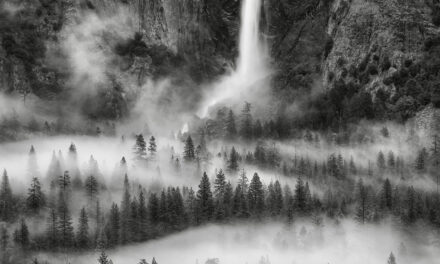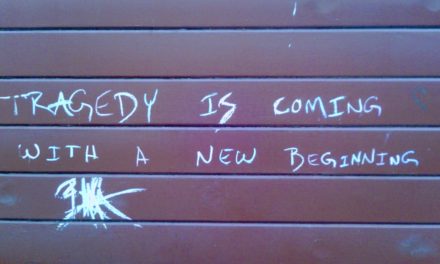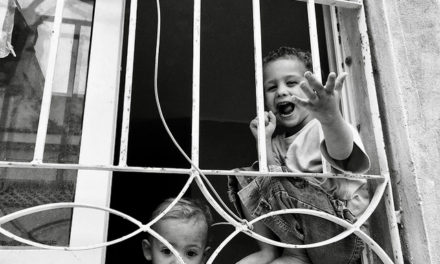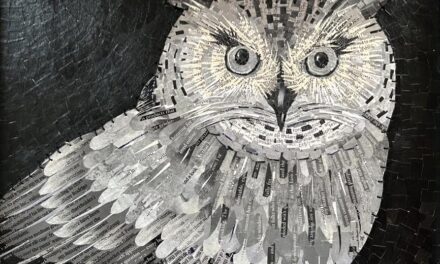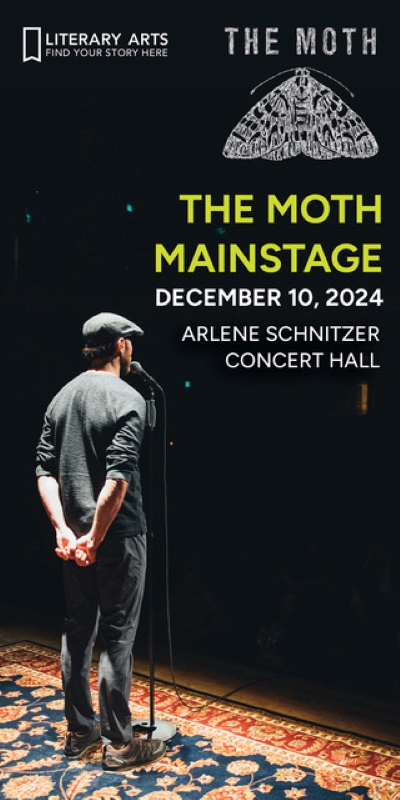(Above: Margaret Coe sits on a fallen tree trunk in the meadow behind her home. The “au naturel” area provided the inspiration for her latest art exhibit, Wild Spaces, at the Karin Clarke Gallery; photos by Paul Carter.)
By Randi Bjornstad
The acre-plus meadow behind artist Margaret “Peg” Coe’s longtime Eugene home not only is a well-loved refuge, it also has served as the muse for her newest body of work, titled Wild Spaces, on display at the Karin Clarke Gallery in downtown Eugene.
“The ‘characters’ in these paintings and eight drawings are the trees and plants in my meadow,” Coe said as she sat amidst the happy chaos of branches and brambles where she has lived for 52 years, most of that time with her late husband and fellow artist, Mark Clarke, who died five years ago.
“There is so much here to appreciate — there are trees that have fallen through the years out there that are lying on their sides, but they are still alive,” she said. “I enjoy honoring this natural landscape, and I can walk down here and draw and paint any time I want.”

Spiritual Awakening is the title of this Margaret Coe painting; the work represents her introspection during the isolation of the pandemic as she took strength from her own backyard meadow and woods; photo courtesy of Karin Clarke Gallery.
The result of her careful study and equally painstaking painting is a show filled with light, shadow, and brilliant color that is inspired by — but not a copy of — what she sees around her each day. Coe said it also represents for her a new exploration of the interconnection between the natural and spiritual world.
“To me, there is something very right about embracing the natural world and having a deep reverence for it,” she said. “I think this is some of my strongest work. To me it feels soulful, work that I am doing at this time in my life that is deeper, for my spirit.”
Much of her previous painting came from frequent trips to other places, including Italy, France, Ireland, and other parts of the United States. But the pandemic both demanded and offered her another way of looking at the world.
“For me, the solitude I had during all the months of the shutdown was something I came to totally embrace,” Coe said. “And being surrounded as I am with all this — the meadow, the woods — I had something that I could be totally engaged with. I was not hibernating — in a sense, I was trying to find what is really important and how to paint my feelings about being here with all this detail that is part of my everyday life.”
In fact, art has been a major detail in Coe’s life from her earliest years, when she lived in the tiny town of Coats, Kan., population a little less than 300, where her father ran the general store. She was the third of four children in the family, “and I was always very shy and somewhat intimidated — my older sister Pat was always in charge, kind of the boss,” she recalled.
She didn’t even know the word “artist” at the age of 6 when Pat came home from school one day “all excited because she had learned how to draw a stick figure,” Coe said. “She showed me how, and I remember I thought, ‘Why would you put a line like that for an arm, it doesn’t make sense.”
So she drew her own picture, using curved parallel lines for the arms. “Pat suddenly said, ‘Mom, Peggy’s an artist,’ and because I didn’t know what that meant, at first I thought I was in trouble for something,” Coe said. “Then I realized that it really was something good — from then on, I knew I was an artist.”
Once she knew what drawing was, Coe started drawing everyday things that she came across, such as characters from comic strips. Her first set of paints came from the local drugstore. “It went on sale, and we bought it, but the paint was very hard and dried out,” so it wasn’t usable, she said.
When she was in seventh grade, the family relocated to Salem, because a number of other relatives already lived in that area of Oregon. One house had several reproductions of paintings in it, and when her grandmother saw a landscape in the background of a photo she received, she expressed an interest in it.
“My mom said, ‘Oh, Peggy can make you one like that,’ and she bought me a tabletop easel, a canvas board, and paints,” Coe said. “It was my job to paint a reproduction of a reproduction.”
It proved to be a valuable step in the girl’s art education.
“When I looked very closely, I realized the artist had used a lot of violet in the distant part of the scene, something I wouldn’t have noticed until I was trying to recreate it,” Coe said. “From then on, I started painting a lot of things, like a little ballerina behind a curtain — another relative wanted that one — and a painting of a storm and a swing blowing in the wind.”
By the time she was in high school, her reputation as an artist had begun to grow.
“I had a boyfriend, and he said he wanted a painting I had done of the coast for his graduation present,” she said with a laugh. “He said it was because he thought I would be famous someday and he would have a valuable painting.”
In one case, however, her adolescent painting ended in censorship. Like many in her age group, she was enthralled by movies starring bad-boy actors such as Marlon Brando and James Dean, and she chose to paint a scene reminiscent of Dean’s movie, Rebel Without a Cause, showing a young man in a posture that evoked the possibility of an impending street fight.
“I submitted it to the Oregon State Fair, and it was disqualified,” Coe said. “They said it was too provocative.”
After high school, she enrolled at the University of Oregon, intending to major in painting, “but my dad said that was ridiculous — he didn’t think you could make a living painting — so I switched to art education.”
That wasn’t a bad decision, though, Coe acknowledged. “After I graduated, I was doing some post-grad work in painting, and because of my art education degree, I was given a position as a teaching assistant in art. I also filled in at North Salem High School.”
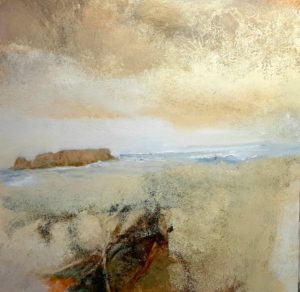
The Mystery is one of several coastal paintings included in Margaret Coe’s Wild Spaces show at the Karin Clarke Gallery
She distinctly remembers the first time she saw her husband-to-be, Mark Clarke, who had just finished two years in the Army and returned to the UO for a graduate degree in art.
“He was five years older than I was, so he had done two years at OSU and then two years at the UO before he was drafted and spent the next two years in the service,” she said.
“I saw him coming out of the grad school with a big painting that he was going to photograph,” she recalled. “He was a big, tall guy wearing a smock, carrying a camera and that big painting. I remember a message that came clearly into my mind — “There he is” — and I don’t know if I really heard it as a voice, but the message was just so strong. At first I thought maybe it just meant maybe he could be a mentor or something, but later I realized it was much more than that. He really made an impression — he looked like a real artist.”
As they gradually got to know each other, the often reticent Clarke told her once that her hands looked like the hands of a classical Greek statue. Another time, he told her that she looked like a movie star.
“I thought maybe because he was so big and I was so tiny, he meant I looked like Audrey Hepburn,” Coe laughed. “But later, when he finally told me, he said I reminded him of Gregory Peck.”
Both taciturn by nature, it took a long time to establish their eventual close relationship.
“We thought of each other as good friends,” Coe said. “Once we were having a hard time deciding whether to go to an on-campus movie — we both loved foreign films — and another friend got tired of listening to us and said, ‘Get a room’ — that was the first time I ever heard that saying.”
However, they did decide to go to the film and took in a double feature of Ingmar Bergman’s work: Wild Strawberries followed by The Seventh Seal.
Eventually, Coe said, the subject of marriage came up in a typically obliquely manner when Clarke said to her one day, “You ought to think about marrying me.”
During the early years of their marriage, Clarke worked at the then-called University of Oregon Museum of Art, and Coe continued to take some art classes, including weaving from renowned textile and metalwork artist Max Nixon and painting from equally renowned artist David McCosh.
At some point, “someone asked me if I wanted to do the graduate program in painting, and all I had to do was put up my paintings on the wall and meet with (faculty) people to look at it and critique it,” Coe recalled. She was admitted but left the program when she became pregnant “because I couldn’t handle the fumes from the paints and turpentine,” she said.
Ultimately, they had two children. Tim Clarke is a professional jazz trumpeter who lives in Buffalo, N.Y., Karin Clarke Johns is a painter and owner of the Karin Clarke Gallery and the recently opened Karin Clarke Gallery at the Gordon, both in downtown Eugene.
Coe finished her master’s degree in painting in the mid-1970s, and that’s when she decided to use her full maiden name, Margaret Coe, on her work.
“I had started out using Peg Coe Clarke when we were first married and I was in my 20s,” she said. “Then, because we were both so influenced by David McCosh and his teaching, sometimes people couldn’t tell for sure whether a painting was mine or Mark’s, so I started using Peg Coe. When I finished my graduate degree, I decided that since Peg was just a nickname, I should use my real name. It was confusing for awhile when some people didn’t know Peg Coe Clarke, Peg Coe, and Margaret Clarke were the same person.”
As two painters in the same household, Clarke and Coe had very different methods of working, but their respect for each other “gave us a kind of synergy, or camaraderie” but never competition, Coe said.

Le Mystère reflects Margaret Coe’s deep reflections during the pandemic on the relationship between nature and self.
“Early on, it was good for me because he was five years older and had more experience than I did, and then for some time he was painting while I was raising kids,” she said. “We talked about art, and we respected the same painters, but when it came to doing it, I guess we were both kind of loners — we each had our own studio space — but our painting habits were very different.”
Clarke was a morning person — he often rose at 6 a.m. and met friends for coffee while the still-asleep Coe found her inspiration later in the day.
And, while he liked to do spend an hour and a half or so starting a piece of work plein air and then finish his paintings back at in his studio, Coe preferred to work much longer in the scene.
“I liked to work three hours or even more at a time — once I start a painting, I’m in a zone, and I don’t want to stop,” she said. “I find my inspiration in the present, and I guess I have a certain amount of stamina to want to remain in that environment.”
The Wild Spaces exhibit with its 21 oil paintings and additional drawings reflects that immersion, but it also is different from some of her previous work because of the materials she used, primarily portrait grade linen and transparent oils.
“Last time I did a residency in Venice (Italy), I splurged and bought the linen,” Coe said. “I stretched and prepared it and thought I would just see what I could do, and I think it worked really well, with the super-smooth surface and the look of transparency.”
Although she has spent a significant amount of time in the past painting in other regions and countries, Coe doesn’t see that happening in the future.
“I am so attached now to this place that I want to explore it further,” she said. “Also, I’m at an age where it is not as easy to travel — it doesn’t fit my physical nature any more. But I am just loving my land so much, it’s where I want to be.”
While the Wild Spaces exhibit focuses mainly on interpretations from Coe’s own nearby nature, it also includes several interpretations of one of her favorite beaches on Oregon’s central coast.
Wild Spaces
When: Through Sept. 25
Where: Karin Clarke Gallery, 760 Willamette St., Eugene
Special events:
- Meet the Artist reception — 4 p.m. to 8 p.m. on Friday, Aug. 27
- Downtown Eugene’s First Friday ArtWalk — 5:30 p.m. to 7:30 p.m. on Friday, Sept. 3
Gallery hours: Noon to 5:30 p.m. Wednesday through Friday, 10 a.m. to 4 p.m. Saturday
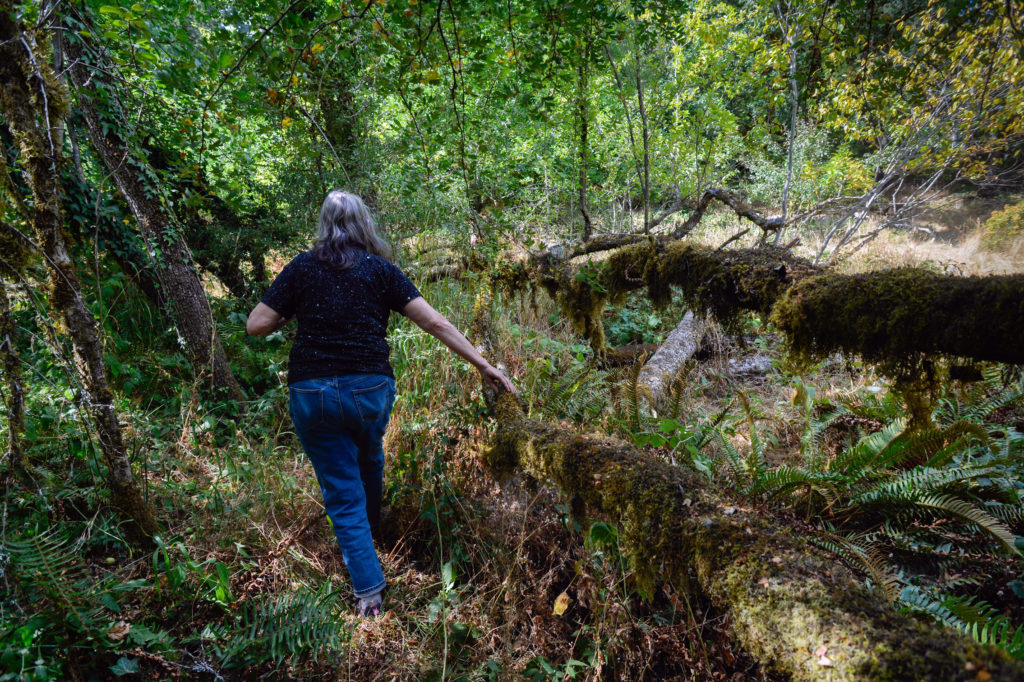
Margaret Coe hikes through the grounds behind her east Eugene home. The lush natural vegetation inspired her latest artwork, a show called Wild Spaces.


